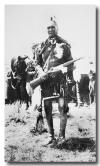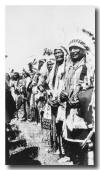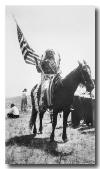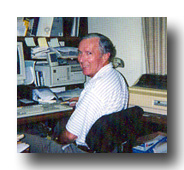| Friends Of The Little Bighorn Battlefield |
The Next Generation In The Study Of Custer's Last Stand |
Custer's Last Fight |
| • The Battle • Archeology • Memorials • Little Bighorn Store • News • Book Reviews |
Custer's Last Fight:Remembered by Participants at the Tenth Anniversary June 25, 1886 and the Fiftieth Anniversary June 25, 1926by Richard UptonPhotos courtesy Richard Upton from his bookBook Review by Bob Reece June 2006
Crowd during 50th anniversary events. Notice people, in foreground, standing amongst the Custer markers which are inside the fence today. In Richard Upton’s The Battle of the Little Bighorn & Custer’s Last Fight: Remembered by Participants at the Tenth Anniversary June 25, 1886 and the Fiftieth Anniversary June 25, 1926, we discover commemoration events of the anniversary of the Battle of the Little Bighorn haven’t changed much over the years. During the 50th anniversary, attendees were treated to a military plane fly-over; those who attended the 125th anniversary witnessed an honor fly-over of military jets, and they thought they were the first. In 1926, a funeral service for an unknown soldier from the 7th Cavalry was conducted at Garryowen. The Park Service performed the same in the Custer National Cemetery during the late 20th century. The one striking difference is that in 1926, many participants who once faced each other in the heat of battle came together in peace and reached out to shake hands. Military plane flies over the crowd during the 50th anniversary commemoration events at the Little Bighorn Upton, a long-time publisher of Upton and Sons (books about Custer and the Little Bighorn), shares countless photos from his private collection of the 1926 anniversary. The photos, willed to Upton by battlefield lover George Osten, make this book worthwhile. Osten was host to Godfrey and his wife during the 1926 anniversary, and provided transportation for them to all events. Upton waited decades to share these photos and tell the story of the 50th anniversary events. He has chosen the ideal moment to release this book: during the 130th anniversary of the battle. The battlefield novice and expert alike will enjoy Upton’s book. Inside the front cover is a replication of the official program from the June 24-26, 1926 events. Inside the back cover is the list of the committee members, which included General E. S. Godfrey as chairman, and committee members such as Libbie Custer, Edgerly, and Graham to name a few. The first 39 pages focus on the 10th anniversary with accounts given by Gall and Godfrey. The 50th anniversary takes up most of the remainder of the book with accounts from many newspapers. This becomes redundant at times; however, it is interesting to see how these events were reported at the time. The star of Upton’s book is the photography. Many of the photographs have never before been published, and each are captioned for the event. A few captions are not completely clear regarding the photo in question, but they do not detract from the quality or importance of this book. Photos of landscapes, crowds, and individual participants from the battle are found throughout the book: White Man Runs Him, William Slaper, White Bull, Godfrey, Black Elk, and more are included. Additionally, there are photos of the people who didn’t fight in the Battle of the Little Bighorn, but attended in 1926. These included George Bird Grinnell, Captain Luther North, Col Portello, and Tom LaForge. White Man Runs Him -- one of Custer's four scouts
One of my favorite photos is of participants standing upon Last Stand Hill amongst the headstones of the Ft. Phil Kearny dead, with Slaper holding the U.S. flag. William Slapper holding U.S. Flag -- next to headstones of the Ft. Phil Kearny dead first buried on Last Stand Hill. Slaper was a private in Company M during the Custer Battle and saw action in the Valley and Hilltop Fights. Slaper would die just five years after attending these events.
Richard Upton is very generous to allow The Friends of Little Bighorn Battlefield share with you this most rare, never before published, photo of the Ft. Phil Kearny dead upon Last Stand Hill.
Of all the written accounts that covered the 50th anniversary, Major A. B. Ostrander wrote one of the most interesting. In describing the approach to Last Stand Hill by the participants, he noted, “Slowly they marched to the National cemetery to the strains of a funeral dirge played by the band of the Seventh, concealed in a nearby ravine. From the other side came in a far flung column the hundreds of Indians, led by the nearly 80 Sioux and Cheyenne survivors of the battle headed by White Bull, who as a youth of 20 led a band of Sioux fighters under Rain-in-the-Face. Near the monument the two parties met. White Bull held up his hand making the sign of Peace. General Godfrey replied by dropping his unsheathed sword into its scabbard as he rode forward to meet the Indians. They clasped hands, and to cement the friendship White Bull presented to the General a prized possession – his blanket – while the General gave to White Bull a large American flag.” The 7th Cavalry enters the battlefield
Upton’s book also covers in great detail the burial of the unknown 7th Cavalryman at Garryowen. The reader will discover that, along with White Bull’s tomahawk placed in the crypt, there was a copy of “Boots and Saddles”, and letters from Libbie Custer to the Custer Memorial Committee along with many more items. The book concludes with coverage of the Reno Marker dedication as reported by the Hardin “Tribune-Herald” of August 14, 1929. Upton also includes a letter Libbie wrote to Mr. J. A. Shoemaker begging him to make sure Reno’s name appears on no marker at the battlefield. Next time you visit the Reno-Benteen Battlefield make note of the Monument there – you’ll find no names upon it, but only the letters for the seven companies that fought to survive on June 25-26, 1876. The Appendices are fascinating, especially Appendix A, which is the official register of the three-day event. The names that grace this register are amazing. Included are: F. G. Burnett, “sole survivor of the Hayfield Fight, fought Aug 1, 1867” and “Joseph P. Sinsel, Butte, Mont., age 72, served under Gen. Gibbon & Col. Brooks, Nez Perce Campaign of 1877.” The reader will also discover the many names of the soldiers and Indians from the battle who participated in the anniversary events. For most of those who study this battle the focus is on movements and skirmish lines of troops, and where warriors probed their lines. One tries to understand where certain people fell on both sides because of angry men killing each other. Upton, however, presents an uncommon reflection: soldiers and warriors came together for many days; they shared dances, parades, and horse races, and saw airplanes fly overhead to honor them. They walked upon the ground where they once killed, and where they witnessed friends and loved ones die horrible deaths, but amazingly, in just 50 short years by virtue of forgiveness, they approached each other in peace and friendship forever more. Indian warriors who fought Custer
Magnificent photo taken at the 50th of a battle participant proudly waving the U.S. Flag Books On The Horizon Home |
. |
|
|
Copyright 1999-2016 Bob Reece Friends Little Bighorn Battlefield, P.O. Box 636, Crow Agency, MT 59022 | Home |
Board of Directors |
Guest Book | Contact | Site Map
| |
||






